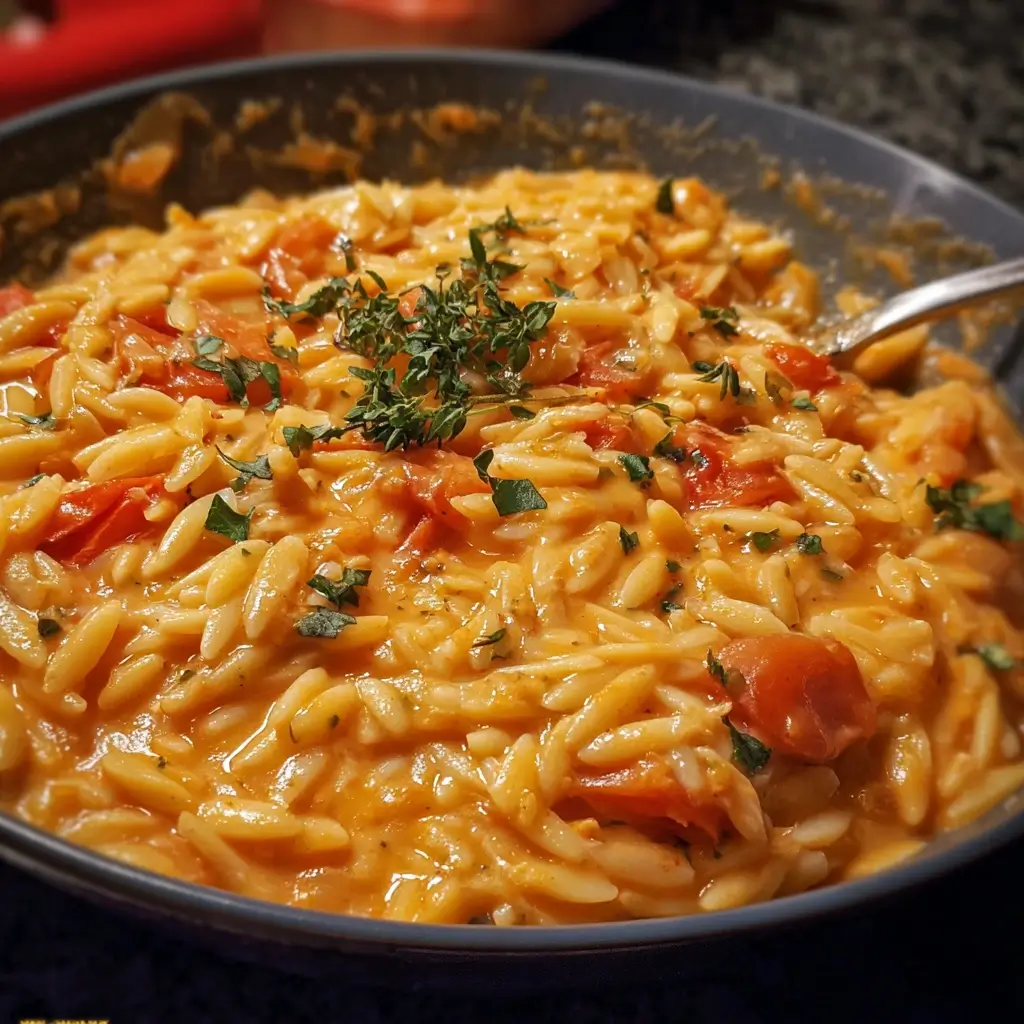Of all the recipes that have graced my family’s dinner table, few have achieved the legendary status of this Creamy Tomato Orzo. It started as a desperate, “what-do-we-have-in-the-pantry” kind of meal on a hectic Tuesday evening. The kids were hungry, my husband was tired, and I was staring down the barrel of another uninspired dinner. I grabbed a box of orzo, a can of tomatoes, and a few kitchen staples, hoping for something merely edible. What emerged from that single pot thirty minutes later was nothing short of magic. The orzo, plump and tender, was bathed in a luxuriously creamy, vibrant tomato sauce that clung to every tiny piece of pasta. It was rich without being heavy, comforting without being complicated. The first bite silenced the table, followed by a chorus of “Wow, this is really good!” It has since become our most requested weeknight dinner, our go-to comfort food, and the dish I bring to friends who’ve just had a new baby. It’s proof that the most memorable meals don’t require hours of effort or a grocery list a mile long—just simple, good ingredients coming together in perfect harmony. This dish isn’t just a recipe; it’s a solution, a hug in a bowl, and a guaranteed win for any night of the week.
Ingredients
- 2 tablespoons Extra Virgin Olive Oil: The foundation of our flavor base. A quality olive oil will lend a subtle, fruity richness that you can’t get from other fats.
- 1 large Yellow Onion, finely chopped: Provides a sweet, aromatic depth that mellows beautifully as it cooks down. Its sweetness is crucial for balancing the acidity of the tomatoes.
- 4-6 cloves Garlic, minced: The heart and soul of so many savory dishes. Use fresh cloves for the most pungent, vibrant flavor; the pre-minced jarred variety can sometimes have a muted or slightly acidic taste.
- 1 teaspoon Dried Oregano: This classic Mediterranean herb adds a peppery, earthy note that is synonymous with Italian-inspired tomato sauces.
- ½ teaspoon Red Pepper Flakes (optional): For a gentle warmth that builds in the background. Feel free to adjust the amount based on your personal preference for heat.
- 1 pound (16 ounces) Orzo Pasta: This small, rice-shaped pasta is the star of the show. Its size and shape make it perfect for absorbing the sauce, resulting in a dish that’s creamy and cohesive.
- 1 (28-ounce) can Crushed Tomatoes: This is the backbone of our sauce. Crushed tomatoes provide the ideal texture—not too chunky, not too smooth—and a concentrated, bright tomato flavor. For an even deeper, smokier flavor, try using fire-roasted crushed tomatoes.
- 4 cups Vegetable Broth: This is our primary cooking liquid for the orzo. Using broth instead of water infuses the pasta with an extra layer of savory flavor from the inside out. Opt for a low-sodium variety to better control the final saltiness of the dish.
- 1 cup Heavy Cream: The secret to the ultimate creamy texture. It enriches the sauce, tames the acidity of the tomatoes, and creates a velvety mouthfeel that is simply irresistible.
- 1 cup grated Parmesan Cheese, plus more for serving: Use freshly grated Parmesan for the best results. It will melt smoothly into the sauce without clumping and provides a nutty, salty, umami-packed punch that ties everything together.
- ½ cup Fresh Basil, chopped: Added at the very end, fresh basil lends a bright, sweet, and slightly peppery finish that cuts through the richness of the cream and cheese.
- Salt and Freshly Ground Black Pepper, to taste: Essential for enhancing all the other flavors. Seasoning is a personal journey, so be sure to taste and adjust at the end of cooking.
Instructions
This one-pot wonder is designed for ease and efficiency, building layers of flavor in a single piece of cookware. Follow these steps closely to ensure your Creamy Tomato Orzo is a resounding success.
Step 1: Build the Aromatic Foundation
Place a large Dutch oven or a heavy-bottomed pot over medium heat. Once the pot is warm, add the two tablespoons of extra virgin olive oil and let it heat for a moment until it shimmers. Add the finely chopped yellow onion and a generous pinch of salt. The salt will help draw moisture out of the onion, allowing it to soften without browning too quickly. Sauté the onion, stirring occasionally, for about 5-7 minutes. You’re looking for the onion to become soft, translucent, and sweet. This process, often called “sweating,” is crucial for developing the deep, savory-sweet base of the sauce. Once the onions are softened, add the minced garlic, dried oregano, and red pepper flakes (if using). Stir constantly and cook for another 60 seconds until the garlic is incredibly fragrant. Be very careful during this step not to let the garlic burn, as it will turn bitter and spoil the flavor of the entire dish.
Step 2: Toast the Orzo and Create the Sauce
Pour the dry, uncooked orzo directly into the pot with the aromatics. Stir well to coat every grain of pasta with the flavorful oil. Continue to stir and cook the orzo for about 2-3 minutes. This toasting step is a game-changer; it enhances the orzo’s natural nutty flavor and helps it maintain its texture during the cooking process, preventing it from becoming overly mushy. After toasting, pour in the entire can of crushed tomatoes. Use a wooden spoon or spatula to stir everything together, scraping up any browned bits (known as “fond”) that may have stuck to the bottom of the pot. This fond is concentrated flavor, and incorporating it into the sauce is essential.
Step 3: Simmer to Perfection
Pour the four cups of vegetable broth into the pot. Stir everything thoroughly to combine. Increase the heat to medium-high and bring the mixture to a gentle boil. Once it’s bubbling, reduce the heat to a medium-low to maintain a steady, gentle simmer. Allow the orzo to cook in the simmering liquid, uncovered, for about 10-12 minutes. It’s important to stir frequently—every couple of minutes—to prevent the orzo from sticking to the bottom of the pot and to ensure it cooks evenly. The orzo will absorb the flavorful liquid, and the starches it releases will begin to naturally thicken the sauce. The orzo is done when it is al dente, meaning it’s tender but still has a slight bite to it.
Step 4: The Luxurious Creamy Finish
Once the orzo is cooked to al dente perfection, turn the heat down to the lowest possible setting. Pour in the heavy cream and the grated Parmesan cheese. Stir gently but continuously until the cheese has completely melted and the cream is fully incorporated. The sauce will transform into a beautiful, pale orange-pink color and become incredibly velvety and rich. At this point, turn off the heat completely. Stir in the chopped fresh basil. Give the dish a final taste and season generously with salt and freshly ground black pepper as needed. The flavors will have concentrated during cooking, so it’s crucial to taste and adjust at the end. Let the dish rest for 5 minutes before serving; this allows the sauce to thicken slightly more and the flavors to meld together perfectly.
Nutrition Facts
- Servings: 6-8 servings
- Calories per serving: Approximately 450-550 kcal (This is an estimate and can vary based on specific ingredients like the fat content of the cream and broth used.)
- Carbohydrates: As a pasta-based dish, this recipe is a significant source of carbohydrates, which are the body’s primary source of energy. The complex carbs from the orzo provide sustained energy.
- Protein: The Parmesan cheese and, to a lesser extent, the pasta itself, contribute a moderate amount of protein, which is essential for building and repairing tissues in the body.
- Fat: The majority of the fat content comes from the heavy cream, olive oil, and Parmesan cheese. This fat adds richness, flavor, and helps with the absorption of fat-soluble vitamins.
- Sodium: The sodium content can be controlled by using low-sodium vegetable broth and seasoning with salt at the end of cooking, allowing you to adjust it to your dietary needs.
- Fiber: The tomatoes and onions provide some dietary fiber, which is important for digestive health and can help you feel full and satisfied.
Preparation Time
This recipe is designed to be a quick and efficient meal, perfect for busy weeknights.
- Preparation: 10 minutes. This includes time for chopping the onion, mincing the garlic, and measuring out all the ingredients. Practicing “mise en place”—having everything prepped and ready before you start cooking—will make the process smooth and stress-free.
- Cook Time: 25-30 minutes. This is the active cooking time, from sautéing the onions to letting the finished dish rest. Since it all happens in one pot, cleanup is also remarkably fast.
How to Serve
This Creamy Tomato Orzo is a wonderfully versatile main course that can be served in many ways. Here are some of our favorite combinations to round out the meal:
- Classic and Simple Pairings:
- Crusty Garlic Bread: Absolutely essential for sopping up every last bit of the delicious, creamy sauce.
- Simple Green Salad: A salad with a bright, acidic vinaigrette (like a lemon or balsamic dressing) provides a fresh, crisp contrast to the richness of the pasta. Arugula or mixed greens work perfectly.
- Protein Additions to Make it a Heartier Meal:
- Grilled or Shredded Chicken: Seasoned grilled chicken breast, sliced and served on top, is a classic and satisfying addition.
- Sautéed Shrimp: Quickly sauté some shrimp with garlic and butter and fold them in at the end for a fantastic surf-and-turf-inspired pasta dish.
- Italian Sausage: Browned and crumbled spicy or sweet Italian sausage can be mixed in to add a savory, meaty depth.
- Canned Chickpeas: For a plant-based protein boost, rinse and drain a can of chickpeas and stir them in during the last few minutes of cooking.
- Vegetable Enhancements:
- Wilted Spinach or Kale: Stir in a few large handfuls of fresh spinach or kale along with the cream and cheese. The residual heat will wilt the greens perfectly.
- Roasted Vegetables: Serve alongside a medley of roasted vegetables like broccoli, bell peppers, or zucchini for extra nutrients and flavor.
- Sautéed Mushrooms: Earthy mushrooms, sautéed with a bit of butter and thyme, complement the creamy tomato sauce beautifully.
- Finishing Touches and Garnishes:
- A drizzle of high-quality balsamic glaze.
- An extra sprinkle of freshly grated Parmesan cheese.
- A pinch of red pepper flakes for more heat.
- More fresh basil or a sprinkle of fresh parsley.
Additional Tips
Unlock the full potential of your Creamy Tomato Orzo with these eight professional tips.
- Don’t Overcook the Orzo: This is the most critical tip. Orzo cooks quickly and can go from al dente to mushy in a minute. Start checking for doneness a couple of minutes before the recipe suggests. It should have a slight chew. Remember, it will continue to cook from the residual heat even after you turn off the stove.
- Use High-Quality Canned Tomatoes: The tomato is a star flavor, so its quality matters immensely. Look for brands like San Marzano or a fire-roasted variety. A better-tasting tomato will create a sauce with more depth, sweetness, and less metallic acidity.
- Scrape the Bottom of the Pot: When you sauté the onions and toast the orzo, little brown bits might form on the bottom of the pot. This is called “fond,” and it’s pure, concentrated flavor. When you add the liquids (tomatoes and broth), use your spoon to scrape these bits up, dissolving them into the sauce for an instant flavor boost.
- Be Prepared to Adjust Liquid: Depending on the brand of orzo, the intensity of your simmer, and even the humidity in your kitchen, you might find the dish needs a bit more liquid. If the orzo seems to be absorbing the broth too quickly and the sauce is too thick before the pasta is cooked, don’t hesitate to add another splash of broth or water.
- Toast the Orzo for Deeper Flavor: Don’t skip the step of toasting the dry orzo in the pot with the aromatics. This simple 2-minute step gives the pasta a slightly nutty, complex flavor that adds a whole new dimension to the finished dish and helps it hold its shape.
- Grate Your Own Parmesan: Pre-shredded cheeses are often coated with anti-caking agents like potato starch or cellulose. These agents can prevent the cheese from melting smoothly, resulting in a clumpy or grainy sauce. Buying a block of Parmesan and grating it yourself ensures a silky, perfectly melted consistency.
- Let it Rest Before Serving: Giving the orzo a 5-minute rest after you’ve turned off the heat is crucial. During this time, the pasta will absorb the last bit of excess liquid, and the sauce will thicken up to its ideal, creamy consistency. It’s the final step to a perfect texture.
- Taste and Season at the End: Always do a final taste test before you serve. The saltiness of your broth and Parmesan can vary greatly. You may need a generous amount of salt and pepper at the end to make all the flavors pop. A final squeeze of lemon juice can also brighten everything up if you find it a touch too rich.
Frequently Asked Questions (FAQ)
Q1: Can I make this Creamy Tomato Orzo vegan or dairy-free?
A: Absolutely! To make this dish vegan, make two simple swaps. First, ensure you are using olive oil and not butter for sautéing. Second, substitute the heavy cream with a full-fat, unsweetened coconut milk or a high-quality cashew cream. For the Parmesan cheese, you can use a store-bought vegan Parmesan alternative or stir in 2-3 tablespoons of nutritional yeast at the end for a cheesy, umami flavor. The result will be just as creamy and delicious.
Q2: Is it possible to make this recipe gluten-free?
A: Yes, you can make a gluten-free version. The most direct substitution is to find a gluten-free orzo pasta, which is now available from several brands. Be aware that gluten-free pastas can sometimes cook differently and may require slight adjustments to the cooking time and liquid amount, so follow the package directions as a guide and stir frequently. Alternatively, you could use a similar-sized gluten-free pasta or even arborio rice (which would make it more of a risotto) and adjust the cooking method accordingly.
Q3: What kind of protein can I add to this dish?
A: This recipe is a fantastic base for adding protein. For chicken, you can add cubed, pre-cooked chicken at the end or cook raw chicken pieces in the pot after the onions and before the garlic. For shrimp, add raw shrimp during the last 3-4 minutes of the orzo’s cooking time. For sausage, brown crumbled Italian sausage in the pot first, remove it with a slotted spoon, and add it back in at the end. For a vegetarian option, stir in a can of rinsed chickpeas or white beans along with the cream.
Q4: How do I store and reheat leftovers?
A: Leftovers are fantastic! Store any remaining orzo in an airtight container in the refrigerator for up to 3-4 days. The orzo will continue to absorb the sauce as it sits, so it will be thicker when you reheat it. The best way to reheat is on the stovetop over low heat. Add a splash of milk, cream, or vegetable broth to the pot to loosen the sauce and restore its creamy consistency as you gently stir it back to life.
Q5: Can I freeze this Creamy Tomato Orzo?
A: While you technically can freeze it, be aware that the texture may change upon thawing. Dairy-based sauces can sometimes separate, and the orzo pasta can become a bit softer or mushy. If you do choose to freeze it, let it cool completely, store it in a freezer-safe, airtight container for up to 2 months. Thaw it overnight in the refrigerator and reheat gently on the stovetop, adding a splash of liquid as described above to help reconstitute the sauce.
Q6: My orzo came out gummy and mushy. What did I do wrong?
A: This is a common issue that usually comes down to one of two things: overcooking or over-stirring. Orzo cooks very quickly, so it’s vital to test it for doneness early and often, aiming for al dente. Secondly, while frequent stirring is necessary to prevent sticking, overly vigorous or constant stirring can cause the pasta to release too much starch, leading to a gummy texture. Stir gently every couple of minutes, just enough to keep it moving.
Q7: My sauce seems too thin or too thick. How can I fix it?
A: This is an easy fix! If your sauce is too thin after the orzo is cooked, simply let it continue to simmer for a few more minutes, which will allow more liquid to evaporate and thicken the sauce. If the sauce becomes too thick before the orzo is fully cooked, stir in an extra splash of vegetable broth or warm water until it reaches your desired consistency. The dish is very forgiving in this regard.
Q8: Can I use a different type of pasta?
A: Yes, though small pasta shapes work best for this one-pot method as they cook evenly and create a similar creamy texture. Shapes like ditalini, small shells, or even broken spaghetti pieces would work well. You will need to adjust the cooking time based on the pasta’s package instructions. Avoid large pasta shapes like penne or rigatoni, as they require more liquid and a longer cooking time that would not be suitable for this specific recipe’s ratios.

Creamy Tomato Orzo
- Total Time: 40 minutes
Ingredients
- 2 tablespoons Extra Virgin Olive Oil: The foundation of our flavor base. A quality olive oil will lend a subtle, fruity richness that you can’t get from other fats.
- 1 large Yellow Onion, finely chopped: Provides a sweet, aromatic depth that mellows beautifully as it cooks down. Its sweetness is crucial for balancing the acidity of the tomatoes.
- 4–6 cloves Garlic, minced: The heart and soul of so many savory dishes. Use fresh cloves for the most pungent, vibrant flavor; the pre-minced jarred variety can sometimes have a muted or slightly acidic taste.
- 1 teaspoon Dried Oregano: This classic Mediterranean herb adds a peppery, earthy note that is synonymous with Italian-inspired tomato sauces.
- ½ teaspoon Red Pepper Flakes (optional): For a gentle warmth that builds in the background. Feel free to adjust the amount based on your personal preference for heat.
- 1 pound (16 ounces) Orzo Pasta: This small, rice-shaped pasta is the star of the show. Its size and shape make it perfect for absorbing the sauce, resulting in a dish that’s creamy and cohesive.
- 1 (28-ounce) can Crushed Tomatoes: This is the backbone of our sauce. Crushed tomatoes provide the ideal texture—not too chunky, not too smooth—and a concentrated, bright tomato flavor. For an even deeper, smokier flavor, try using fire-roasted crushed tomatoes.
- 4 cups Vegetable Broth: This is our primary cooking liquid for the orzo. Using broth instead of water infuses the pasta with an extra layer of savory flavor from the inside out. Opt for a low-sodium variety to better control the final saltiness of the dish.
- 1 cup Heavy Cream: The secret to the ultimate creamy texture. It enriches the sauce, tames the acidity of the tomatoes, and creates a velvety mouthfeel that is simply irresistible.
- 1 cup grated Parmesan Cheese, plus more for serving: Use freshly grated Parmesan for the best results. It will melt smoothly into the sauce without clumping and provides a nutty, salty, umami-packed punch that ties everything together.
- ½ cup Fresh Basil, chopped: Added at the very end, fresh basil lends a bright, sweet, and slightly peppery finish that cuts through the richness of the cream and cheese.
- Salt and Freshly Ground Black Pepper, to taste: Essential for enhancing all the other flavors. Seasoning is a personal journey, so be sure to taste and adjust at the end of cooking.
Instructions
This one-pot wonder is designed for ease and efficiency, building layers of flavor in a single piece of cookware. Follow these steps closely to ensure your Creamy Tomato Orzo is a resounding success.
Place a large Dutch oven or a heavy-bottomed pot over medium heat. Once the pot is warm, add the two tablespoons of extra virgin olive oil and let it heat for a moment until it shimmers. Add the finely chopped yellow onion and a generous pinch of salt. The salt will help draw moisture out of the onion, allowing it to soften without browning too quickly. Sauté the onion, stirring occasionally, for about 5-7 minutes. You’re looking for the onion to become soft, translucent, and sweet. This process, often called “sweating,” is crucial for developing the deep, savory-sweet base of the sauce. Once the onions are softened, add the minced garlic, dried oregano, and red pepper flakes (if using). Stir constantly and cook for another 60 seconds until the garlic is incredibly fragrant. Be very careful during this step not to let the garlic burn, as it will turn bitter and spoil the flavor of the entire dish.
Pour the dry, uncooked orzo directly into the pot with the aromatics. Stir well to coat every grain of pasta with the flavorful oil. Continue to stir and cook the orzo for about 2-3 minutes. This toasting step is a game-changer; it enhances the orzo’s natural nutty flavor and helps it maintain its texture during the cooking process, preventing it from becoming overly mushy. After toasting, pour in the entire can of crushed tomatoes. Use a wooden spoon or spatula to stir everything together, scraping up any browned bits (known as “fond”) that may have stuck to the bottom of the pot. This fond is concentrated flavor, and incorporating it into the sauce is essential.
Pour the four cups of vegetable broth into the pot. Stir everything thoroughly to combine. Increase the heat to medium-high and bring the mixture to a gentle boil. Once it’s bubbling, reduce the heat to a medium-low to maintain a steady, gentle simmer. Allow the orzo to cook in the simmering liquid, uncovered, for about 10-12 minutes. It’s important to stir frequently—every couple of minutes—to prevent the orzo from sticking to the bottom of the pot and to ensure it cooks evenly. The orzo will absorb the flavorful liquid, and the starches it releases will begin to naturally thicken the sauce. The orzo is done when it is al dente, meaning it’s tender but still has a slight bite to it.
Once the orzo is cooked to al dente perfection, turn the heat down to the lowest possible setting. Pour in the heavy cream and the grated Parmesan cheese. Stir gently but continuously until the cheese has completely melted and the cream is fully incorporated. The sauce will transform into a beautiful, pale orange-pink color and become incredibly velvety and rich. At this point, turn off the heat completely. Stir in the chopped fresh basil. Give the dish a final taste and season generously with salt and freshly ground black pepper as needed. The flavors will have concentrated during cooking, so it’s crucial to taste and adjust at the end. Let the dish rest for 5 minutes before serving; this allows the sauce to thicken slightly more and the flavors to meld together perfectly.
- Prep Time: 10 minutes
- Cook Time: 30 minutes
Nutrition
- Serving Size: one normal portion
- Calories: 550






